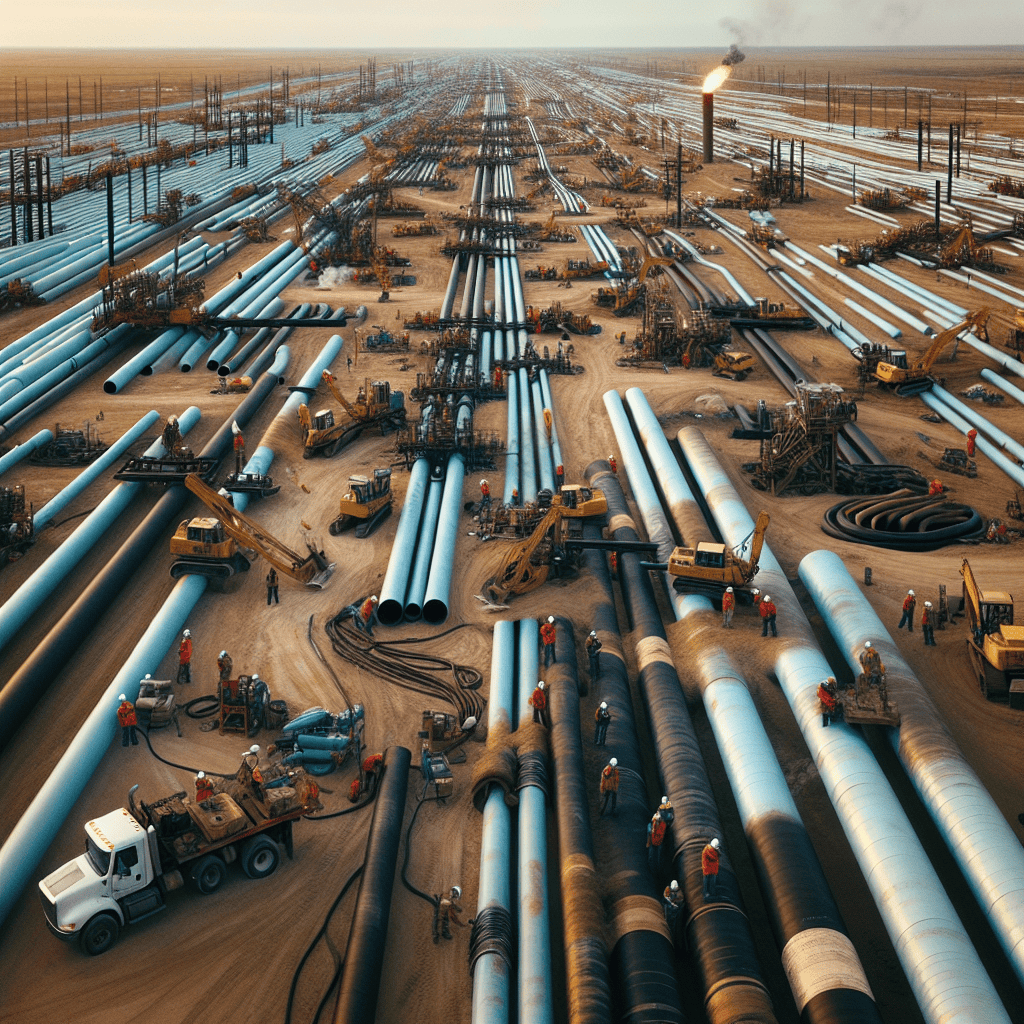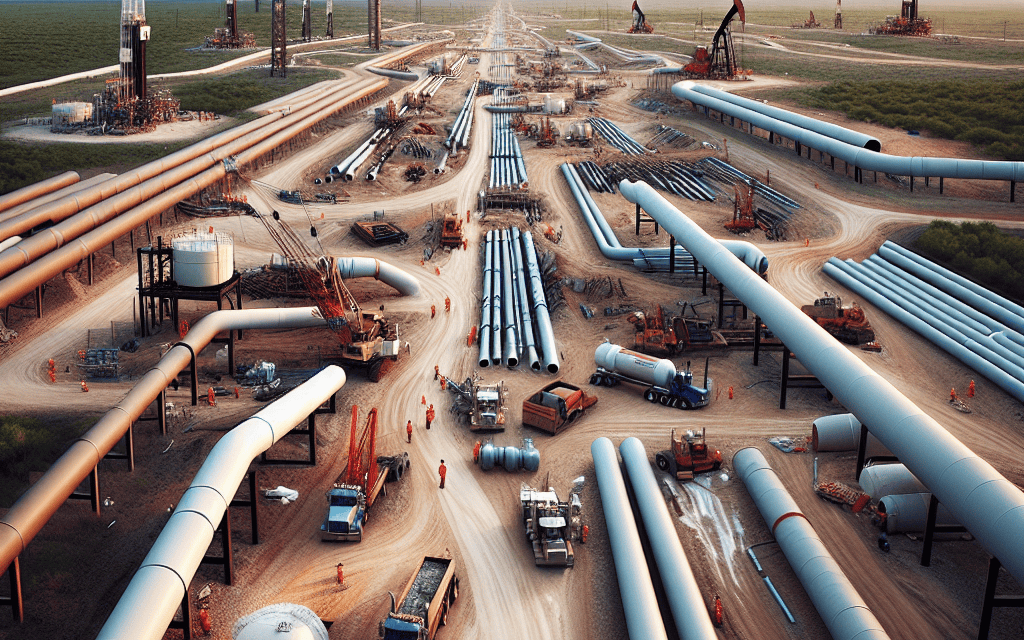“Fueling Progress: Texas Pipeline Expansion Ignites Shale Gas Surge”
Introduction
The Texas pipeline expansion has significantly bolstered shale gas production, marking a pivotal development in the energy sector. This expansion addresses critical infrastructure needs, facilitating the efficient transport of natural gas from prolific shale formations to key markets. By enhancing capacity and reducing bottlenecks, the pipeline expansion supports increased production levels, driving economic growth and energy security. This development not only underscores Texas’s role as a leading energy producer but also highlights the ongoing evolution of the U.S. energy landscape, as technological advancements and infrastructure improvements continue to unlock the potential of domestic energy resources.
Economic Impact of Texas Pipeline Expansion on Local Communities
The recent expansion of the Texas pipeline network has significantly bolstered shale gas production, bringing about notable economic impacts on local communities. This development, driven by the increasing demand for natural gas, has not only enhanced the state’s energy output but also stimulated economic growth in various regions. As the pipeline infrastructure expands, it facilitates the efficient transportation of shale gas from production sites to markets, thereby reducing bottlenecks and optimizing supply chains. Consequently, this has led to a surge in production levels, which in turn has had a ripple effect on local economies.
One of the most immediate benefits observed is the creation of jobs. The construction and maintenance of pipelines require a substantial workforce, providing employment opportunities for local residents. These jobs range from skilled labor positions to roles in engineering and project management, offering a diverse array of employment prospects. Moreover, the increased activity in the shale gas sector has spurred demand for ancillary services, such as catering, transportation, and accommodation, further boosting local businesses and contributing to economic vitality.
In addition to job creation, the expansion of the pipeline network has led to increased tax revenues for local governments. As production levels rise, so do the royalties and taxes paid by energy companies. These funds are crucial for community development, as they can be allocated to improve infrastructure, education, and public services. Enhanced public amenities not only improve the quality of life for residents but also make these areas more attractive to potential investors and new businesses, fostering a cycle of growth and prosperity.
Furthermore, the expansion has encouraged technological advancements and innovation within the energy sector. As companies strive to maximize efficiency and minimize environmental impact, they invest in cutting-edge technologies and practices. This not only enhances the sustainability of shale gas production but also positions Texas as a leader in energy innovation. The knowledge and expertise gained through these advancements can be shared with other regions and industries, amplifying the positive impact of the pipeline expansion beyond local communities.
However, it is important to acknowledge the challenges and concerns associated with pipeline expansion. Environmental and safety considerations are paramount, as the construction and operation of pipelines can pose risks to ecosystems and communities. To address these concerns, stringent regulations and oversight are necessary to ensure that best practices are followed and that any potential negative impacts are mitigated. Engaging with local communities and stakeholders is also crucial, as it fosters transparency and trust, allowing for collaborative solutions that balance economic growth with environmental stewardship.
In conclusion, the expansion of the Texas pipeline network has had a profound economic impact on local communities, driving job creation, increasing tax revenues, and fostering technological innovation. While challenges remain, particularly in terms of environmental and safety concerns, the benefits of this development are significant. By continuing to prioritize sustainable practices and community engagement, Texas can ensure that the positive effects of the pipeline expansion are maximized, contributing to the long-term prosperity of its local communities and the broader energy sector. As the state continues to navigate the complexities of energy production and distribution, the lessons learned from this expansion will undoubtedly inform future endeavors, paving the way for continued growth and success.
Environmental Considerations in Texas Pipeline Expansion Projects
The expansion of pipeline infrastructure in Texas has become a pivotal factor in the enhancement of shale gas production, a development that has significant implications for both the energy sector and environmental management. As Texas continues to solidify its position as a leading energy producer, the expansion of pipelines is seen as a necessary step to accommodate the increasing output from the prolific shale formations. However, this growth is not without its environmental considerations, which have sparked a complex dialogue among stakeholders, including industry leaders, environmentalists, and policymakers.
To begin with, the expansion of pipelines is essential for efficiently transporting the abundant natural gas extracted from shale formations to markets across the United States and beyond. The Permian Basin and the Eagle Ford Shale are two of the most productive regions in Texas, contributing significantly to the state’s energy output. As production in these areas surges, the existing pipeline infrastructure has struggled to keep pace, leading to bottlenecks that can hinder the efficient distribution of natural gas. Consequently, expanding pipeline capacity is crucial to alleviating these constraints and ensuring that the energy supply chain operates smoothly.
Nevertheless, the environmental implications of pipeline expansion cannot be overlooked. One of the primary concerns is the potential impact on local ecosystems and wildlife habitats. The construction of new pipelines often requires clearing land, which can disrupt habitats and lead to a loss of biodiversity. Additionally, there is the risk of leaks and spills, which can have devastating effects on the surrounding environment. These concerns necessitate rigorous environmental assessments and the implementation of robust safety measures to mitigate potential risks.
Moreover, the expansion of pipelines intersects with broader discussions about climate change and the transition to renewable energy sources. While natural gas is often touted as a cleaner alternative to coal, it is still a fossil fuel that contributes to greenhouse gas emissions. The increased production and consumption of natural gas, facilitated by expanded pipeline infrastructure, may therefore pose challenges to efforts aimed at reducing carbon emissions and combating climate change. This has led to calls for a more balanced approach that considers both the immediate energy needs and the long-term environmental goals.
In response to these concerns, regulatory frameworks have been established to ensure that pipeline projects adhere to environmental standards. The Texas Railroad Commission, which oversees the state’s oil and gas industry, plays a crucial role in regulating pipeline construction and operation. Additionally, federal agencies such as the Environmental Protection Agency (EPA) are involved in assessing the environmental impact of large-scale projects. These regulatory bodies are tasked with balancing the economic benefits of pipeline expansion with the need to protect the environment.
Furthermore, technological advancements are being leveraged to minimize the environmental footprint of pipeline projects. Innovations in pipeline materials and construction techniques are enhancing the safety and efficiency of these infrastructures. For instance, the use of advanced monitoring systems can help detect leaks early, reducing the risk of environmental contamination. Such technological solutions are integral to addressing environmental concerns while supporting the growth of the shale gas industry.
In conclusion, the expansion of pipeline infrastructure in Texas is a critical component of the state’s strategy to boost shale gas production. While this development offers significant economic benefits, it also presents environmental challenges that must be carefully managed. Through a combination of regulatory oversight, technological innovation, and stakeholder engagement, it is possible to navigate these challenges and ensure that pipeline expansion projects contribute to a sustainable energy future.
Technological Innovations Driving Texas Pipeline Expansion
The expansion of Texas pipelines is a significant development in the energy sector, particularly in the context of increasing shale gas production. This expansion is not merely a response to rising demand but is also driven by technological innovations that have transformed the landscape of energy infrastructure. As the United States continues to position itself as a leading energy producer, the role of Texas, with its vast shale reserves, becomes increasingly pivotal. The integration of advanced technologies in pipeline construction and management is a key factor propelling this growth.
To begin with, the application of cutting-edge technologies in pipeline monitoring and maintenance has enhanced the efficiency and safety of these infrastructures. Innovations such as smart sensors and real-time data analytics allow for continuous monitoring of pipeline conditions, thereby reducing the risk of leaks and other potential hazards. These technologies provide operators with critical insights into the operational status of pipelines, enabling timely interventions and minimizing downtime. Consequently, this technological advancement not only ensures the integrity of the pipeline network but also supports the sustainable expansion of shale gas production.
Moreover, the use of horizontal drilling and hydraulic fracturing has revolutionized shale gas extraction, making previously inaccessible reserves economically viable. These techniques have significantly increased the volume of gas that can be extracted from shale formations, necessitating an expansion of pipeline capacity to transport the increased output. The synergy between extraction technologies and pipeline innovations underscores the importance of an integrated approach to energy production and distribution. As a result, Texas has witnessed a surge in pipeline projects aimed at accommodating the burgeoning supply of shale gas.
In addition to technological advancements in extraction and monitoring, the development of more durable materials for pipeline construction has played a crucial role in the expansion efforts. The introduction of high-strength steel and corrosion-resistant coatings has extended the lifespan of pipelines, reducing maintenance costs and enhancing reliability. These materials are designed to withstand the harsh environmental conditions often encountered in shale regions, ensuring that the infrastructure can support long-term production goals. This focus on durability and resilience is essential for maintaining the momentum of shale gas production in Texas.
Furthermore, the integration of digital technologies in pipeline management has streamlined operations and improved decision-making processes. The use of artificial intelligence and machine learning algorithms allows for predictive maintenance, optimizing resource allocation and minimizing operational disruptions. These technologies facilitate a proactive approach to pipeline management, ensuring that potential issues are addressed before they escalate into significant problems. This level of operational efficiency is critical for sustaining the growth of shale gas production and maintaining the competitiveness of Texas in the global energy market.
In conclusion, the expansion of Texas pipelines is a testament to the transformative impact of technological innovations in the energy sector. By enhancing the efficiency, safety, and reliability of pipeline infrastructure, these advancements have enabled Texas to capitalize on its abundant shale gas reserves. As the demand for energy continues to rise, the integration of technology in pipeline expansion efforts will remain a key driver of growth. This ongoing evolution underscores the importance of innovation in meeting the challenges of modern energy production and distribution, positioning Texas as a leader in the global energy landscape.
Regulatory Challenges in Texas Pipeline Expansion

The expansion of pipeline infrastructure in Texas, a state renowned for its vast shale gas reserves, has been a pivotal factor in boosting shale gas production. However, this expansion is not without its challenges, particularly in the realm of regulatory oversight. As Texas continues to lead the nation in energy production, the regulatory landscape surrounding pipeline expansion has become increasingly complex, necessitating a careful balance between fostering growth and ensuring safety and environmental protection.
To begin with, the regulatory framework governing pipeline expansion in Texas is multifaceted, involving both state and federal agencies. The Texas Railroad Commission (RRC), despite its name, is the primary state agency responsible for regulating the oil and gas industry, including pipelines. Meanwhile, the Federal Energy Regulatory Commission (FERC) oversees interstate natural gas pipelines. This dual oversight can sometimes lead to regulatory overlap, creating challenges for companies seeking to expand their pipeline networks. Navigating these regulatory waters requires a comprehensive understanding of both state and federal requirements, which can be a daunting task for even the most seasoned industry players.
Moreover, the rapid pace of pipeline expansion has raised concerns about environmental impacts and land use. Environmental groups and local communities have voiced apprehensions about the potential for spills, leaks, and other environmental hazards associated with increased pipeline activity. These concerns have prompted calls for stricter environmental regulations and more rigorous impact assessments. In response, regulatory bodies have been tasked with implementing measures to mitigate these risks, such as mandating more robust safety protocols and requiring detailed environmental impact studies before granting approval for new projects.
In addition to environmental considerations, landowners’ rights present another layer of complexity in the regulatory landscape. The use of eminent domain to acquire land for pipeline construction has been a contentious issue, with many landowners challenging the fairness and necessity of such actions. This has led to legal battles and calls for reform in how eminent domain is applied in the context of pipeline expansion. Regulators must therefore strike a delicate balance between facilitating infrastructure development and respecting the rights of landowners, a task that requires careful negotiation and often, legislative intervention.
Furthermore, the regulatory challenges are compounded by the need to ensure the safety and integrity of the pipeline infrastructure. As pipelines age and new ones are constructed, maintaining their safety becomes paramount. Regulatory agencies have implemented stringent safety standards and inspection protocols to prevent accidents and ensure the reliability of the pipeline network. However, the sheer scale of pipeline infrastructure in Texas poses significant challenges in terms of monitoring and enforcement, necessitating ongoing investment in technology and personnel to uphold these standards.
In conclusion, while the expansion of pipeline infrastructure in Texas has undeniably bolstered shale gas production, it has also brought to the fore a host of regulatory challenges. Balancing the need for economic growth with environmental protection, landowner rights, and safety concerns requires a nuanced approach from both regulators and industry stakeholders. As Texas continues to navigate these challenges, the lessons learned will likely serve as a blueprint for other states grappling with similar issues in their pursuit of energy development. Through collaborative efforts and adaptive regulatory frameworks, Texas can continue to lead in energy production while safeguarding its environmental and social landscapes.
The Role of Texas Pipeline Expansion in U.S. Energy Independence
The expansion of pipeline infrastructure in Texas has emerged as a pivotal factor in bolstering shale gas production, thereby playing a significant role in advancing U.S. energy independence. As the United States continues to strive for energy self-sufficiency, the development of efficient transportation networks for natural gas is crucial. Texas, with its vast reserves of shale gas, has become a focal point for such infrastructural enhancements. The state’s pipeline expansion not only facilitates the efficient movement of natural gas from production sites to markets but also addresses the logistical challenges that have historically impeded the full exploitation of shale resources.
In recent years, the surge in shale gas production has been remarkable, driven by technological advancements such as hydraulic fracturing and horizontal drilling. These innovations have unlocked previously inaccessible reserves, positioning the United States as a leading producer of natural gas. However, the rapid increase in production has necessitated a corresponding expansion in pipeline capacity to ensure that the gas can be transported to where it is needed most. Texas, being home to some of the largest shale formations in the country, including the Permian Basin and the Eagle Ford Shale, has been at the forefront of this infrastructural development.
The expansion of pipelines in Texas has had a multifaceted impact on the energy landscape. Firstly, it has alleviated bottlenecks that previously constrained the flow of natural gas, thereby enhancing the efficiency of the supply chain. This improvement in logistics has not only reduced costs for producers but also ensured a more stable supply of natural gas to domestic and international markets. Moreover, the increased capacity has enabled producers to respond more swiftly to market demands, thereby enhancing the competitiveness of U.S. natural gas on the global stage.
Furthermore, the pipeline expansion has contributed to environmental benefits by reducing the need for flaring, a process where excess natural gas is burned off due to a lack of transportation options. By providing a reliable means of transporting gas, pipelines help minimize waste and lower greenhouse gas emissions, aligning with broader environmental goals. Additionally, the infrastructure development has spurred economic growth in Texas, creating jobs and stimulating investment in local communities.
The role of Texas pipeline expansion in U.S. energy independence cannot be overstated. By ensuring a steady and reliable supply of natural gas, the United States can reduce its reliance on foreign energy sources, thereby enhancing national security. Moreover, the ability to export surplus natural gas strengthens the country’s position in the global energy market, providing leverage in international trade negotiations.
In conclusion, the expansion of pipeline infrastructure in Texas is a critical component in the quest for U.S. energy independence. By facilitating the efficient transportation of shale gas, these pipelines not only support increased production but also contribute to economic growth, environmental sustainability, and national security. As the United States continues to navigate the complexities of the global energy landscape, the strategic development of pipeline networks will remain an essential element in achieving long-term energy goals. Through continued investment and innovation, Texas stands poised to play a central role in shaping the future of energy in the United States and beyond.
Texas Pipeline Expansion: Opportunities for Job Creation
The recent expansion of Texas’s pipeline infrastructure marks a significant milestone in the state’s energy sector, particularly in the realm of shale gas production. This development not only underscores Texas’s pivotal role in the national energy landscape but also heralds a wave of economic opportunities, particularly in terms of job creation. As the demand for energy continues to rise, the expansion of pipelines is crucial for efficiently transporting the abundant shale gas extracted from the prolific Permian Basin and other rich deposits across the state. This infrastructural enhancement is poised to facilitate increased production, thereby reinforcing Texas’s status as a leading energy producer.
The expansion of pipeline networks is a complex endeavor that requires a substantial workforce, thereby creating numerous job opportunities across various sectors. From the initial stages of planning and design to the actual construction and maintenance of the pipelines, a diverse array of skills and expertise is essential. Engineers, construction workers, environmental scientists, and safety inspectors are just a few of the professionals whose expertise is indispensable in ensuring the successful completion of these projects. Consequently, the pipeline expansion is expected to generate thousands of jobs, providing a significant boost to local economies and contributing to the overall economic growth of the state.
Moreover, the ripple effects of job creation extend beyond the immediate employment opportunities within the pipeline projects themselves. As the infrastructure expands, ancillary industries such as manufacturing, transportation, and logistics are also likely to experience growth. The increased demand for materials and equipment necessary for pipeline construction will stimulate manufacturing activities, while the need for efficient transportation of these materials will bolster the logistics sector. This interconnected growth across multiple industries underscores the far-reaching economic impact of the pipeline expansion.
In addition to direct and indirect job creation, the expansion of Texas’s pipeline infrastructure is expected to enhance energy security and stability. By facilitating the efficient transport of shale gas, the expanded pipelines will help to ensure a steady supply of energy to meet both domestic and international demands. This, in turn, can lead to more stable energy prices, benefiting consumers and businesses alike. Furthermore, the increased production capacity enabled by the expanded infrastructure can enhance the United States’ position in the global energy market, potentially leading to increased exports and further economic benefits.
However, it is important to acknowledge the challenges and considerations associated with such large-scale infrastructure projects. Environmental concerns, regulatory compliance, and community engagement are critical factors that must be addressed to ensure the sustainable and responsible development of pipeline networks. Balancing economic growth with environmental stewardship is essential to maintaining public trust and securing the long-term viability of the energy sector.
In conclusion, the expansion of Texas’s pipeline infrastructure represents a significant opportunity for job creation and economic growth, while also reinforcing the state’s leadership in shale gas production. By facilitating increased energy production and enhancing energy security, the expanded pipelines are poised to deliver substantial benefits to both the local and national economies. As Texas continues to navigate the complexities of energy development, the successful implementation of these projects will depend on a collaborative approach that prioritizes both economic and environmental considerations. Through careful planning and execution, the pipeline expansion can serve as a model for sustainable energy development, offering valuable lessons for other regions seeking to harness their own energy resources.
Future Prospects of Shale Gas Production in Texas Post-Expansion
The recent expansion of pipeline infrastructure in Texas marks a significant milestone in the state’s shale gas production capabilities, promising to reshape the energy landscape in the region. This development is poised to enhance the efficiency and capacity of transporting natural gas from the prolific shale formations, such as the Permian Basin and the Eagle Ford Shale, to key markets across the United States and beyond. As a result, the future prospects of shale gas production in Texas appear increasingly promising, with potential implications for both the domestic energy market and global energy dynamics.
To begin with, the expansion of pipeline infrastructure addresses one of the most critical bottlenecks in shale gas production: transportation. Historically, the rapid increase in shale gas extraction has often outpaced the development of necessary infrastructure, leading to constraints in moving the gas from production sites to consumers. By alleviating these transportation challenges, the new pipelines are expected to facilitate a more seamless flow of natural gas, thereby optimizing production levels and reducing costs associated with storage and flaring. Consequently, producers can now operate with greater efficiency, potentially leading to increased output and more competitive pricing.
Moreover, the expanded pipeline network enhances the reliability and security of energy supply, which is crucial for meeting the growing demand for natural gas. As Texas continues to play a pivotal role in the U.S. energy sector, the ability to deliver gas consistently and efficiently is paramount. This reliability not only benefits local economies but also strengthens the position of the United States as a leading energy exporter. With improved infrastructure, Texas is better equipped to meet international demand, particularly in regions seeking to diversify their energy sources and reduce reliance on coal and oil.
In addition to boosting production and export capabilities, the pipeline expansion also has significant environmental implications. By reducing the need for flaring, which is the burning of excess natural gas, the new infrastructure contributes to lower greenhouse gas emissions. This aligns with broader efforts to transition towards cleaner energy sources and mitigate the environmental impact of fossil fuel extraction. Furthermore, the increased efficiency in gas transportation can lead to a more sustainable energy supply chain, as it minimizes waste and maximizes resource utilization.
Looking ahead, the expansion of Texas’s pipeline infrastructure is likely to spur further investment in the state’s shale gas sector. As transportation constraints are alleviated, producers may be more inclined to invest in new technologies and drilling techniques, further enhancing production capabilities. This could lead to a virtuous cycle of growth and innovation, positioning Texas as a leader in the global energy market.
However, it is important to consider the potential challenges that may arise from this expansion. Regulatory hurdles, environmental concerns, and community opposition are factors that could impact the pace and scope of future developments. Therefore, it is essential for stakeholders to engage in transparent and constructive dialogue to address these issues and ensure that the benefits of the pipeline expansion are realized in a sustainable and equitable manner.
In conclusion, the expansion of pipeline infrastructure in Texas represents a pivotal development in the state’s shale gas production landscape. By enhancing transportation efficiency, boosting production capabilities, and contributing to environmental sustainability, this expansion sets the stage for a promising future in shale gas production. As Texas continues to navigate the complexities of the energy sector, the expanded pipeline network will undoubtedly play a crucial role in shaping the state’s economic and environmental trajectory.
Q&A
1. **What is the Texas Pipeline Expansion?**
The Texas Pipeline Expansion refers to the development and enlargement of pipeline infrastructure in Texas to transport natural gas more efficiently from shale formations to markets.
2. **Why is the expansion necessary?**
The expansion is necessary to accommodate the increasing production of shale gas in Texas, ensuring that the gas can be transported to meet growing demand both domestically and internationally.
3. **Which shale formations are primarily affected by this expansion?**
The Permian Basin and the Eagle Ford Shale are the primary formations affected by the pipeline expansion, as they are major sources of shale gas production in Texas.
4. **What are the economic benefits of the pipeline expansion?**
The economic benefits include job creation during the construction phase, increased tax revenues for local and state governments, and enhanced energy security and export potential for the U.S.
5. **How does the expansion impact gas prices?**
By increasing the capacity to transport gas, the expansion can help stabilize or potentially lower gas prices by reducing bottlenecks and ensuring a steady supply to meet demand.
6. **What are the environmental concerns associated with the expansion?**
Environmental concerns include potential impacts on land and ecosystems during construction, the risk of leaks or spills, and the contribution to greenhouse gas emissions from increased fossil fuel production.
7. **Who are the major companies involved in the Texas Pipeline Expansion?**
Major companies involved typically include large energy firms and pipeline operators such as Kinder Morgan, Energy Transfer Partners, and Enterprise Products Partners, among others.
Conclusion
The expansion of Texas pipelines has significantly bolstered shale gas production by enhancing the transportation infrastructure necessary to efficiently move natural gas from production sites to markets. This development has alleviated previous bottlenecks, reduced transportation costs, and increased the overall capacity for gas distribution. As a result, producers can now exploit shale reserves more effectively, leading to a surge in production levels. Additionally, the improved infrastructure supports the state’s economic growth by attracting investments and creating jobs, while also contributing to energy security and meeting rising domestic and international demand for natural gas. However, this expansion also raises environmental and regulatory considerations that need to be addressed to ensure sustainable development.





